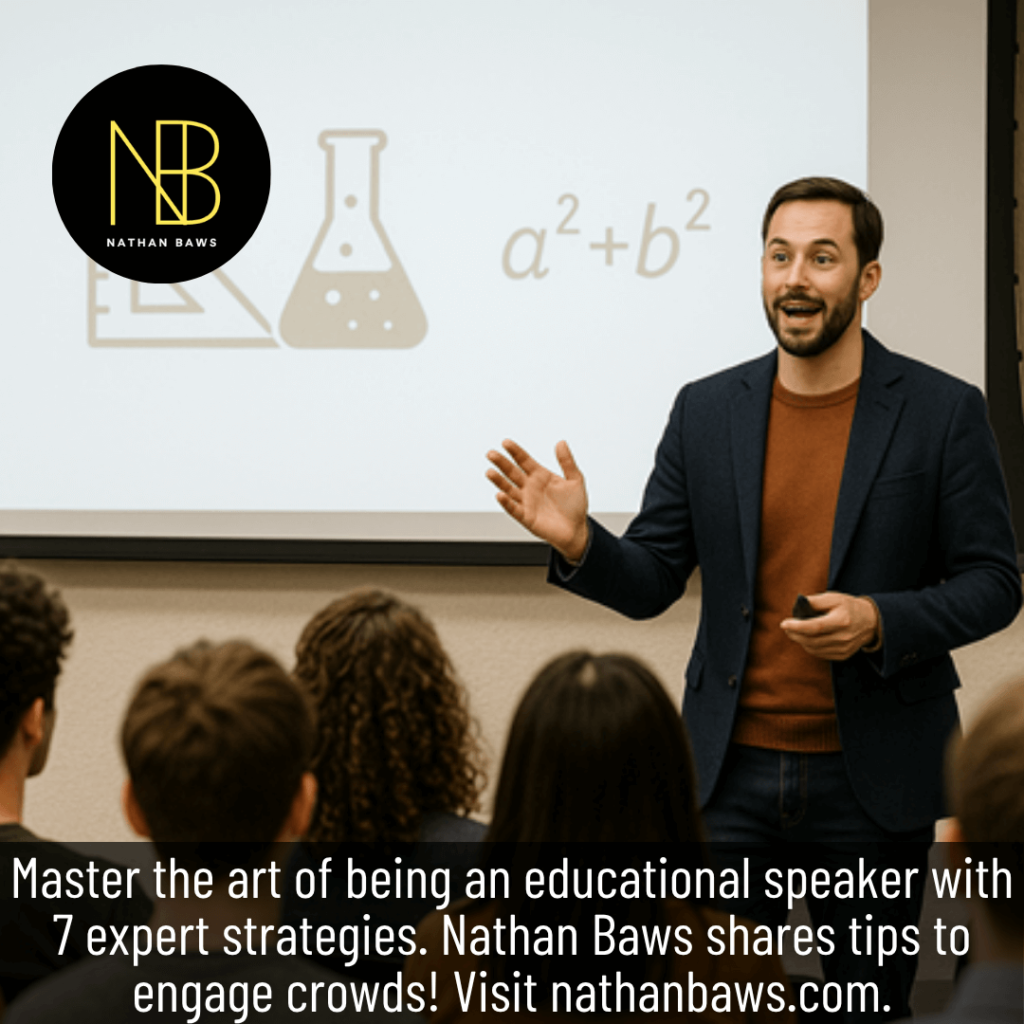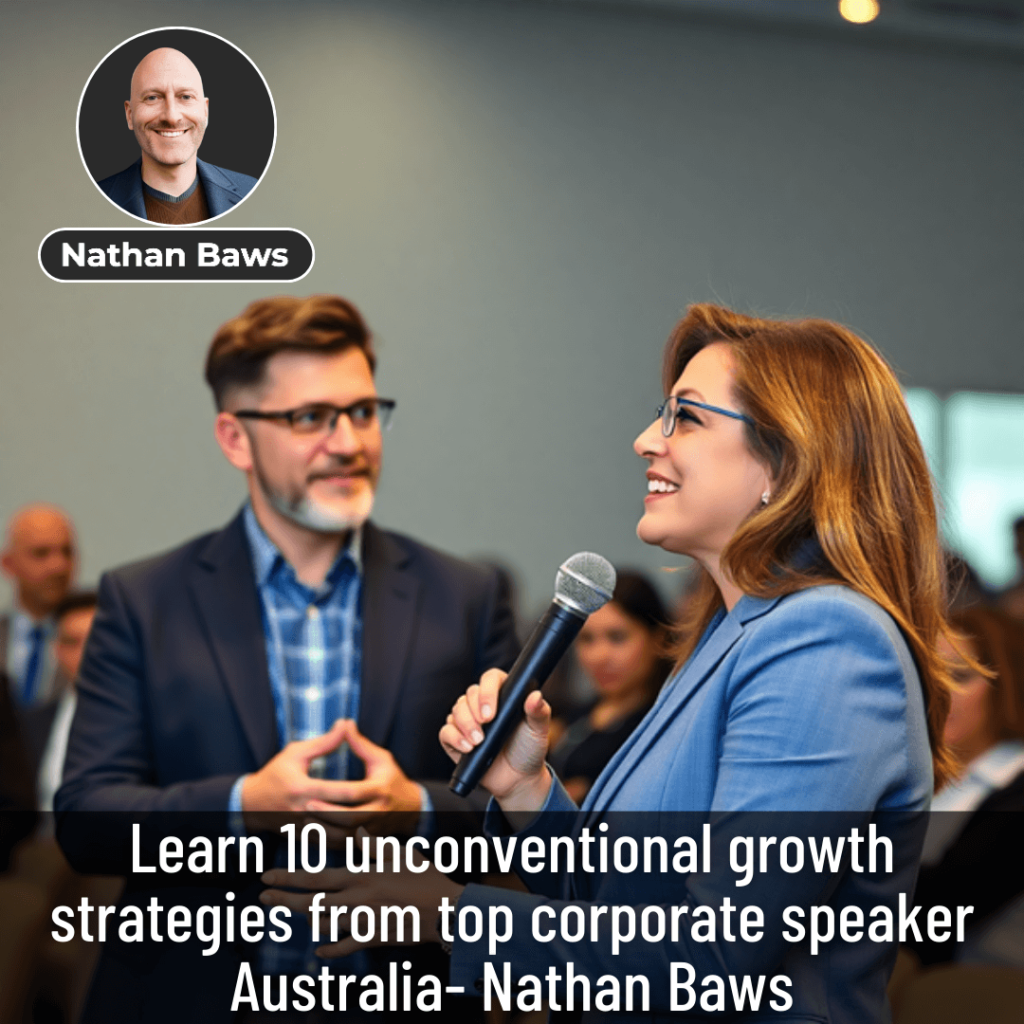Introduction
Have you ever seen educational speakers stand up and change a quiet room into a room full of ideas? That is what we are talking about here. I’m Nathan Baws. I have spent years helping educational speakers all over Australia. We know what works when it comes to talks that help people learn and stay interested. If you are a teacher, trainer, or speaker, these seven tips will help you become an educational speaker people remember. Let’s get started.
Key Takeaways
- Hook your audience fast.
- Structure talks to make learning stick like glue.
- Engage diverse crowds, from teens to execs, with practical tools.
- Build confidence to shine as educational speakers under pressure.
- Discover how Nathan Baws can boost your skills as educational speakers.
1. Start with a Hook That Grabs Attention
As educational speakers, your first 30 seconds are make-or-break. A strong opening sets the tone and pulls the audience into your world.
Why Your Opening Matters
Educational speakers must capture focus instantly, or you’ll lose the crowd to their phones. A dull start, like chatting about the weather, flops. Instead, use a bold question, like, “Who’s ever struggled to keep students engaged?” or a stat, like, “70% of learners forget lessons without interaction.” This shows you’re an educational speaker who gets their challenges.
Crafting a Winning Hook
Make it relevant and punchy. For example, in a talk for teachers, try, “Raise your hand if a boring lesson’s tanked your class.” It’s direct and builds rapport. Tease the value you’ll deliver, like better engagement or retention. Educational speakers who start strong keep listeners locked in.
Avoiding Common Mistakes
Don’t ramble about yourself or say, “I’m stoked to be here.” Skip cheesy icebreakers like “share your favourite subject.” Focus on the audience’s needs, and you’ll cement your role as educational speakers who deliver from the get-go.
2. Structure Talks So People Remember
A good educational speaker organises their talk clearly. The talk should be simple to follow. It should have a clear structure, like a lesson plan. That makes it easier for people to remember the message.
Why Structure Matters
When a talk is well organised, people remember more. As an educational speaker, it helps to break your talk into clear steps. You can use three to five key points. You can say, “First, we talk about this,” then move to the next point. It guides people. It helps them stay with you.
How to Make the Talk Clear
Begin with a short introduction. Tell people what you will talk about. For each point, explain the idea. Give a real example or some evidence. You can also share a simple tip that people can use. At the end, remind them of the key points. Educational speakers who plan like this make their talk easy to follow. People remember more.
Real Example
In one workshop, we used three steps — Plan, Teach, Reflect. Teachers used the steps the next day. They said it helped students focus better. That shows how a simple plan from an educational speaker can help. It turns a talk into something useful.
3. Keep the Audience Involved
It is hard to learn if people sit quietly the whole time. Educational speakers know that. They find ways to make people take part. That keeps energy up. It helps people remember.
Why It Helps
When people take part, they learn more. They remember the talk. Whether it is students or adults, people enjoy being part of the talk. Educational speakers who use this make the talk more than just words.
Simple Ways to Involve People
You can ask questions. You can ask people to talk in pairs. You can do a short group activity. You can ask people to raise their hand. It keeps them listening. It helps the ideas stay with them. Educational speakers who do this keep people interested.
Know Your Audience
Young students like games. Adults may like real examples. In one university talk, we asked teachers to share what worked for them in class. We linked that to our message. Watch the room. Some groups need to move. Others need questions. Educational speakers who notice this and change their talk do better.
4. Use Real Examples to Explain Ideas
It helps to share real stories. A good educational speaker does not only talk about theory. They share real examples. That helps people understand. It makes the ideas feel real.
Why Examples Work
Our brains retain examples 65% better than abstract ideas. A real-world case, like a teacher boosting engagement with quizzes, makes your advice tangible. Educational speakers who use examples turn vague concepts into actionable insights.
Choosing the Right Examples
Match examples to your audience. For educators, share a classroom success, like a Sydney school that raised grades 15% with daily check-ins. For trainers, use a corporate case, like a team improving output with a new method. Keep examples concise—two minutes max—and tie them to your point. Educational speakers balance examples with data for credibility.
Keeping It Balanced
One example per key point is enough. In a recent talk, we shared how a Perth trainer used role-plays to lift team morale, backed by a 20% productivity stat. This mix keeps your talk engaging and authoritative, a hallmark of skilled educational speakers.

5. Build Confidence with Good Preparation
Confidence is important for educational speakers. When you prepare well, you feel ready. You speak better.
Why Preparation Matters
If you know your talk, you do not have to look at your notes all the time. You can look at the people listening. You also feel ready if something goes wrong, like a tech problem. Educational speakers who practise sound clear. They look sure of themselves.
Simple Ways to Prepare
First, plan your talk. Then practise speaking out loud. Do this many times. You can record yourself and listen. It helps you notice small things, like saying “um” too often. You can also ask someone to listen and give feedback. Time your talk. Leave space for questions at the end. We teach educational speakers to do this. It helps them feel ready.
Handling Nerves
Feeling nervous is normal. It happens to everyone. You can breathe slowly to help. Breathe in for four seconds. Hold your breath. Then breathe out. Imagine people listening and smiling. We had a client do this before a big conference. It helped. Educational speakers who prepare and stay calm speak with confidence.
6. Adapt to Your Audience’s Vibe
Every crowd is different. Skilled educational speakers read the room and tweak their approach to keep everyone hooked.
Why Adaptation Matters
A talk for teenagers is not the same as a talk for business leaders. You must know who you are speaking to. Their age, their job, their challenges. Educational speakers who change their talk to suit the audience keep people interested.
Watch and Adjust
It helps to learn about your audience before the talk. During the talk, look at how people react. If they nod, they are following. If they look bored or restless, you may need to change something. You can ask a question or add a short activity. In one seminar, the teachers looked restless. We changed to a group task. It helped. Educational speakers who notice these things and adapt do better.
Practical Tweaks
For a lively crowd, add a game; for a serious one, lean on data. Ask, “Share a challenge you’ve faced,” to draw out quiet groups. Flexibility ensures educational speakers connect with any audience, from kids to corporates.
7. Close with a Bang and a Plan
Your closing is your final shot to inspire. Educational speakers use it to recap, motivate, and spark action.
Why Endings Matter
A strong close shapes what listeners take away. A weak one—like trailing off—fizzles out. Recap your points, tie back to your opening, and give a clear next step, like trying a new engagement tactic. Educational speakers who end well leave a lasting mark.
Crafting a Powerful Close
Summarise each point briefly: “We covered hooks, structure, and engagement.” Add a call to action, like, “Try one tip this week.” End with a punchy line, like, “Great educational speakers don’t just talk—they transform.” This inspires and sticks.
Avoiding Closing Flops
Don’t rush or toss in new ideas. Skip vague endings like “That’s it!” In a recent talk, we asked teachers to commit to one strategy, and many followed through. A clear, motivating close ensures educational speakers leave the crowd ready to act.
Conclusion
You now have seven simple tips to help you become a better educational speaker. These steps can help you plan your talk, hold attention, and leave people with ideas they remember. At Nathan Baws, we help educational speakers like you share knowledge and build confidence. If you want help to improve your skills or bring a fresh talk to your school or workplace, visit https://nathanbaws.com/. We can help you as an educational speaker.
Also Read: 10 Unorthodox Growth Hacks That Helped Me Thrive After Shark Tank
FAQs
What makes a good educational speaker?
A good educational speaker teaches clearly. They use examples and simple tips people can use. They change their talk to suit the audience. They prepare well. They focus on helping people, not showing off. They structure the talk clearly and always end with a useful takeaway.
How can educational speakers deal with nerves?
It is normal to feel nervous. Many educational speakers feel this. Practise your talk well. Breathe slowly. Picture yourself doing well. You can ask a question at the start to help settle in. With time, nerves feel easier to manage.
Why are examples helpful for educational speakers?
Examples make ideas simple to understand. They help people remember. A real story or case study shows how your tips work. Good educational speakers use short, clear examples that fit the audience.
How should an educational speaker start a talk?
Start with something that makes people listen. You can ask a question or share a simple fact. It should link to your message. Avoid long introductions. A strong start shows you are ready as an educational speaker.
How do educational speakers make talks useful?
Share simple tips people can try. Explain them step by step. Give real examples so they see how it works. That helps them remember and use what you say.
Why does body language matter for educational speakers?
Body language shows how sure you are. Stand straight. Look at the people. Use your hands to help explain. Try not to fidget. It helps people listen better.
How do educational speakers keep people interested?
Involve the group. Ask questions. Do small tasks. Watch the room. If people look bored, change it up. A good educational speaker keeps people involved the whole time.
How much practice do educational speakers need?
Practise until you feel ready. Say your talk out loud many times. Record yourself to spot small issues. Check your time. Leave space for questions. Educational speakers who practise feel more confident and speak better.
How do educational speakers change their talk for different groups?
First, know who you are talking to. Are they young? Are they adults? What do they need? During the talk, watch how they react. If they look lost, explain more. If they seem bored, add an activity. Educational speakers who change their talk like this connect better.
How do educational speakers know if their talk worked?
Look at how people react. Are they listening? Do they ask questions? Do they speak to you after? You can also ask for feedback. If people use your ideas later, your talk made a difference. That is the goal for every educational speaker.


